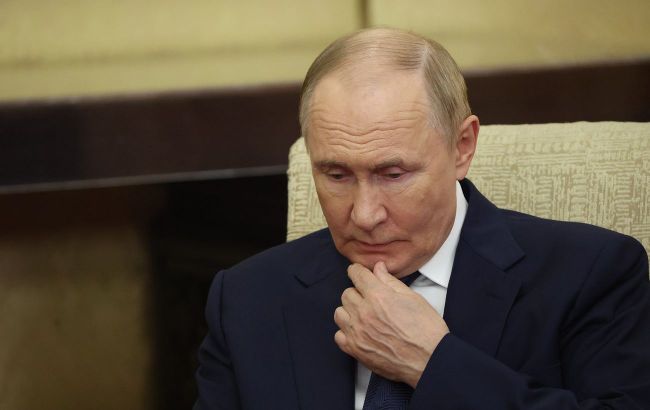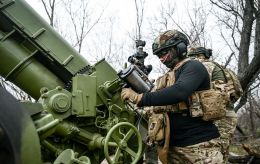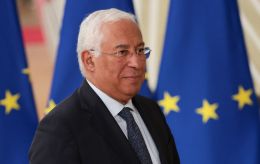Russia's war chest will run dry in two years? What's wrong with its economy and who keeps it afloat
 Vladimir Putin is concerned about the growing problems in the economy (photo: Getty Images)
Vladimir Putin is concerned about the growing problems in the economy (photo: Getty Images)
Russia's GDP is falling, and with it, oil and gas revenues. Even military factories are already planning to cut staff. RBC-Ukraine analyzes whether the Russian economy is in decline, where Putin's regime can find additional resources, and how long it will continue its aggression against Ukraine.
Key questions:
- Has a recession begun in Russia?
- Why are Russia's military factories already cutting workers?
- How is the oil and gas sector declining?
- Where will Russia get resources for next year?
- For how many years has the Kremlin had enough money for its war of aggression?
State of the Russian economy
Russia was very fortunate to accumulate significant funds during periods of high oil prices, when the benchmark Brent grade traded above $100 per barrel. This was in 2003–2008, 2011–2014, and even already during the full-scale invasion, from late winter to the summer of 2022.
Russia's GDP almost replicates the oil price chart. From 2003 to 2021 (inclusive), it grew fourfold — to 5.7 trillion dollars, according to World Bank data. In 2021, the Russian economy grew by almost 6%, but by the end of the first year of the full-scale invasion, it had fallen by 1.4% — a drop in real GDP, adjusted for inflation, despite nominal GDP rising to 2.3 trillion dollars.
During 2023–2024, Russians managed to maintain real GDP growth above 4%, but 2025 revealed the true economic condition of the aggressor state. By the end of this year, Russia's GDP growth is forecast at a minimal level — 0.6% (according to the International Monetary Fund) or 0.5–1.0% (according to the Bank of Russia as of November 6). The Russian central bank also provided a rather modest forecast for 2026 and 2027 — 1% and 2% GDP growth, respectively.
At the beginning of this year, inflation was a significant challenge for Russia, with the official rate exceeding 10% in February–April. To overcome it, the Bank of Russia raised the key rate to 21%. Starting in May, inflation began to decline, and in June, the central bank began lowering the key rate to stimulate the economy.
Crisis of non-payments and specifics of statistics
The main driver of growth in the Russian economy is the military-industrial complex, meaning the production of weapons for the war against Ukraine. The share of the defense industry in the Russian economy is officially 8% (about 160 billion dollars per year). However, if related production is included under other budget lines, this share may reach 12% of GDP. "This is what they are currently spending on the war," former presidential economic adviser Oleh Ustenko told RBC-Ukraine.
Growth driven by weapons production is not connected to investment or consumption in the economy. It therefore brings no benefits now or in the future, since most of the weapons produced go to the front. The growth demonstrated by the Russian economy is burning up in the fire of war, says Ivan Us, chief consultant at the National Institute for Strategic Studies.
This year, even the defense industry has begun to weaken. In previous years, many military factories showed high output thanks to remaining Soviet-era stocks of components and semi-finished equipment. They completed this equipment and transferred it to the Russian Ministry of Defense. Over time, these reserves were exhausted, and the resource base for increasing production fell sharply, Ustenko explains.
The main problem in Russia's state sector is a crisis of non-payments — the Kremlin issues state orders to factories but pays them only partially or not at all. This has led to a shortage of funds at enterprises, resulting in reduced working hours, staff being transferred to a four- or three-day working week, and layoffs.
As an example of such trends, Ivan Us mentioned the Rostselmash plant, which produces tractors, and Uralvagonzavod, the main manufacturer of tanks for the Russian army. The tank factory, the expert says, is even planning to lay off 10% of its personnel by the end of this year.
Overall, the Russian economy is in a nosedive, says Oleh Ustenko, adding that Moscow is currently cut off from international capital and technology markets. "Fixing the state of the Russian economy will be impossible or far too difficult," the expert believes.
To assess Russia's economy accurately, one must understand the specifics of Russian statistics — it cannot reflect a decline even if one exists. The Kremlin has banned the publication of such assessments, Ivan Us explains. Rosstat is directly subordinate to the Ministry of Economy, and the minister will not sign a report containing negative indicators. "They cannot write that they have a decline, so they talk about small growth," the economist adds.
However, Russian bankers are already talking about an economic decline in the first and second quarters of this year. In economic theory, when two consecutive quarters show a decline compared to the previous quarter, this is called a technical recession — not just a slowdown, but still not a full-scale downturn. "When phrases about stagnation appear in Russia, I disagree. The diagnosis for the Russian economy as of now is a technical recession," Ivan Us asserts.
Decline in oil and gas revenues
In addition to the military industry, other important sectors in Russia are also beginning to weaken, in particular the oil and gas industry. Russia's oil export revenues in October fell by 2.3 billion dollars compared to the same month of the previous year, to 13.1 billion dollars. In November, Russia's oil and gas budget revenues are expected to decline by 35% compared to the same period in 2024.
On November 12, the head of the Foreign Intelligence Service, Oleh Ivashchenko, reported to Volodymyr Zelenskyy that due to the decline in oil and gas sector revenues, Russia will lose at least 37 billion dollars in budget income by the end of 2025.
 The Russian oil and gas sector is showing a decline in revenues (photo: Getty Images)
The Russian oil and gas sector is showing a decline in revenues (photo: Getty Images)
"Both regular sanctions against Russia and Ukraine's long-range sanctions are working effectively," Zelenskyy commented on the intelligence report.
The financial indicators of Russia's two main oil and gas companies — Gazprom and Rosneft — have also decreased. For example, in the first half of this year, compared to the first half of 2024, the Gazprom Group (under International Financial Reporting Standards) reduced its net profit by 6%, to 983 billion rubles, and Rosneft by 1.7 times, to 245 billion rubles.
Oil and gas remain the backbone of the aggressor state's economy. Their role is even greater than official statistics indicate (25–27% of GDP). These sectors support numerous related industries and the budgets of entire regions, says Gennadii Kobal, a gas market expert and director of the consulting company ExPro.
The decline in the performance of the oil and gas sector will affect the entire Russian economy and significantly complicate budget planning, especially when prices for the Russian export grade Urals fall to minimal levels — 36 dollars per barrel, as reported by Bloomberg.
"Oil is getting cheaper, sanctions are imposed, missiles are hitting — go ahead and try to calculate the budget," Kobal told RBC-Ukraine, adding that Russia is also seeing declines in metallurgy, mechanical engineering, and the coal industry.
Sources of funds for 2026
Russia needs new sources of funds. Externally, they come from buyers of Russian energy resources, metals, fertilizers, and other products. However, China and India purchase Russian oil and gas at significant discounts; supplies to Indian companies are made in rupees, and the central bank of that country does not allow Russian traders to exchange rupees for dollars, Ivan Us says.
Under the pressure of US secondary sanctions, Indian companies are reducing their consumption of Russian oil. "If India reduces its oil purchases, this means that on an annual basis, Russia may lose from 30 to 50 billion dollars," says Oleh Ustenko.
On the other hand, there are already signals that Beijing will reduce purchases of Russian oil transported by sea. China will continue receiving Russian oil via pipelines, Ustenko notes, but a reduction in seaborne supplies will deprive Russia of at least 10 billion dollars a year. The EU also plans to reduce its consumption of Russian hydrocarbons by approximately 5 billion dollars a year next year.
"Even at the minimum, we are talking about 45 billion dollars (next year) — this will be a loss for Russia from oil sales. This will be the main blow," Ustenko added.
At the same time, the Kremlin still has many internal resources. One of the largest is the National Wealth Fund, accumulated during years of high oil prices. Since the beginning of the full-scale war, Russians have already used most of their liquid part (assets that can be easily converted into cash). From the beginning of 2022 to September 1 of this year, it decreased 2.3 times to 48.9 billion dollars.
Usually, the fund's reserves were used to cover the federal budget deficit, but this year its assets are no longer sufficient to do so. The remaining liquid part of the fund amounts to 3.9 trillion rubles, while the planned budget deficit for this year is 5.8 trillion rubles, Ivan Us explains. He concludes that Russia will either fully spend the fund's money by the end of this year or will conserve it and turn to other sources.
The Kremlin is already planning to raise taxes (a VAT increase from 20% to 22% announced for January 1, 2026), constantly issuing domestic bonds at high interest rates, and may also resort to money emission. Although since 2022 the Bank of Russia has already doubled the money supply — from 66.6 to 120 trillion rubles — while the economy has not doubled. The expert adds that more radical scenarios are also possible — cutting wages, halting pension indexation, and freezing bank deposits, totaling 71 trillion rubles.
Oleh Ustenko mentioned another tool available to the Russian central bank — devaluing the ruble. Such a step would make all Russians poorer, but it would allow the government to collect more rubles from a smaller volume of foreign currency and help close budget gaps.
Unused internal resources will not create an economic miracle, but they will help finance the Kremlin's political goals, and politics for Vladimir Putin has always been and remains the top priority, said Russian political analyst Ivan Preobrazhensky, who left Russia in 2014.
"The economy will remain subordinated to military necessity until it collapses or Putin changes his mind," Preobrazhensky told RBC-Ukraine. The analyst does not yet see economic problems that could stop the aggression. Therefore, the question arises: how long will Russia have the economic resources to continue the war against Ukraine at its current level of intensity?
Forecasts for the Russian economy
The deterioration of the economic situation will increase dissatisfaction among Russia's local elites. "The population is controlled, but the local elites will stimulate various disintegration processes — in fact, this is classical separatism," says Ivan Us, adding that the elites will understand that they need "to get off the train rushing into the abyss." The expert forecasts that such movements will already appear in 2026 and become more pronounced in 2027.
If the Kremlin continues the war against Ukraine and resorts to radical instruments, its economy will last one to two years. "Three years, I believe, is an optimistic scenario for Russia. One to two years, and beyond that, their economy is unlikely to withstand," Us said.
Much will depend on China's position. If it continues close cooperation with Russia, then the Kremlin has the strength to wage the war as it does now for two more years. "For 24 months, they will be able to function this way," says Oleh Ustenko.
If the status quo changes and China begins to reduce its purchases of Russian oil, the timeframe may narrow to 12 months, but even then, its economy will not collapse, Ustenko adds.
Economic problems may complicate the conduct of the war, but they will not stop the aggressor entirely. In Russia, they understand that, under current conditions, in about 2 years, they will no longer have the same opportunities for offensive operations, so they are interested in doing as much as possible within this period.
"The level of aggression will increase, they will try to change the situation in this short perspective — either within 24 months (with China's support) or within 12 months (if China reduces its purchases)," Ustenko believes.
Harsh measures indicate that the regime is already exhausting its resources. The more absurd the economic steps of any autocracy become, and the more aggressive its policies grow, the closer it is to its end. And Putin's regime will not be an exception to this historical pattern.

